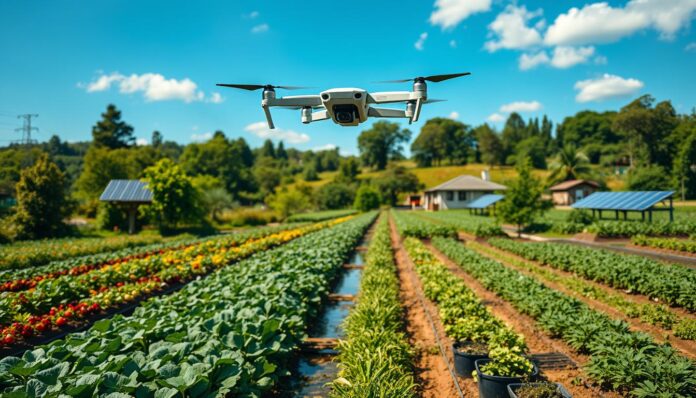Could a small flying device change how we manage sustainable agriculture and regenerative design? Drones are making a big impact in permaculture by giving us new insights into farming.
Permaculture is all about working with nature to design farms. Now, with drones, farmers can get detailed info on crop health and soil conditions. This is thanks to advanced drone tech.
We’re seeing a new era in sustainable farming where tech meets traditional methods. Drones help farmers make better choices by taking high-quality photos and gathering important data. This is all over big farms.
Key Takeaways
- Drones provide unprecedented detailed crop monitoring capabilities
- Precision agriculture reduces environmental impact
- Real-time data collection enhances agricultural efficiency
- Technology enables more sustainable farming practices
- Drone technology supports regenerative design principles
Introduction to Permaculture and Drones
Permaculture is a new way to work with nature. It uses nature’s patterns to make farms that are good for the planet. Permaculture practices use science to make farms that are strong and grow a lot.
Defining Permaculture Principles
The heart of permaculture is three main ethics:
- Care for the Earth
- Care for People
- Fair Share of Resources
Agroforestry systems help follow these ethics. They make farms with many layers to grow more food and protect nature. This way, managing resources becomes easier and more effective.
The Role of Technology in Permaculture
“Technology, when thoughtfully applied, can amplify nature’s inherent intelligence and regenerative capabilities.” – Permaculture Design Handbook
Today, permaculture uses new tech to improve farming. Tools like drones give us a close look at how to take care of the land. They help us watch over the environment and make smart changes.
| Technology | Permaculture Application |
|---|---|
| Drones | Site mapping, crop health monitoring |
| Soil Sensors | Moisture and nutrient tracking |
| AI Software | Design optimization and simulation |
By mixing old wisdom with new tech, farmers can make farms that are better for the planet. These farms can handle changes in the environment better.
Benefits of Drone Technology in Agriculture
Agriculture is changing fast with drone technology. Farmers are using new ways to manage crops and resources. They’re using drones to get better insights into their farms.
Drone technology is changing farming. These drones give farmers new ways to see their farms. They help farmers use resources better and monitor their crops closely.
Enhancing Data Collection Efficiency
Drone technology makes collecting data in farming much better. The main benefits are:
- They can cover up to 70% more area than before.
- They cut down field surveys by 25%.
- They let farmers check on crops in real time.
Precision in Crop Monitoring
Drone systems with biomimic technologies help farmers. They create systems that make farming more efficient. These drones give farmers important information through:
- Multispectral imaging for checking crop health.
- Thermal imaging for better water use.
- High-resolution maps of the fields.
“Drones are changing farming by how we handle field data.” – Agricultural Innovation Research Institute
| Drone Technology Impact | Percentage Improvement |
|---|---|
| Resource Efficiency | 30% Reduction in Input Costs |
| Yield Enhancement | 15% Increase in Crop Production |
| Water Usage Optimization | 20% Reduction in Water Consumption |
The future of farming is all about new tech. Drones are a big part of this change. They help make farming more sustainable, efficient, and precise.
Types of Drones Used in Permaculture
Drone technology has changed sustainable agriculture a lot. It gives farmers new ways to see their land and crops. Knowing about different drones helps farmers work more efficiently.
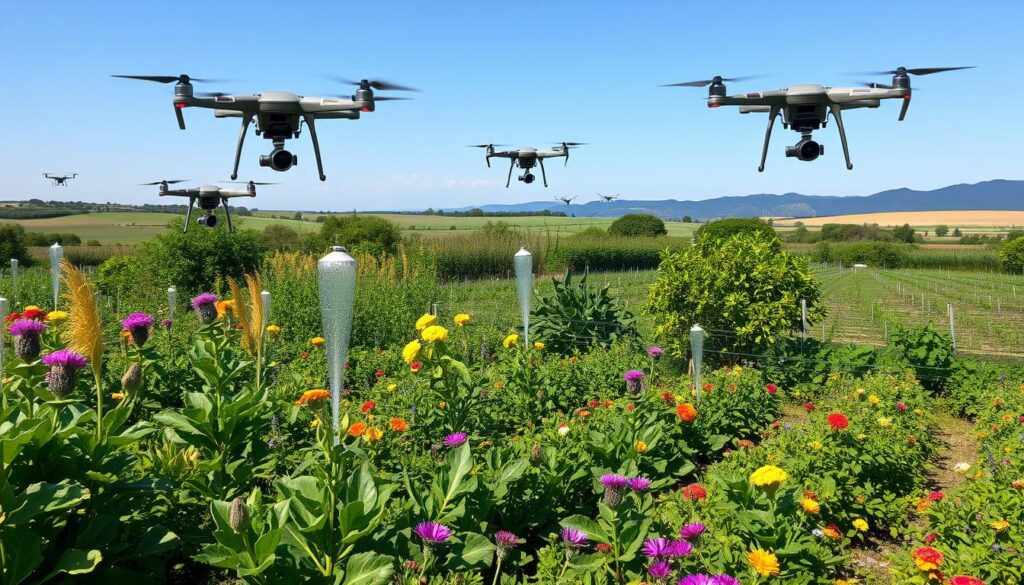
Drone tech is changing how farmers manage their land and watch their crops. Seventy percent of farmers say drones have made their work better. These flying tools are key in modern permaculture.
Fixed-Wing Drones: Efficiency in Large-Scale Monitoring
Fixed-wing drones are great for big farms. They have several benefits:
- Longer flight times (up to 60 minutes)
- Greater range coverage
- More efficient mapping capabilities
- Lower energy consumption
“Fixed-wing drones are game-changers in sustainable agriculture, providing comprehensive landscape assessments with minimal resource investment.”
Multirotor Drones: Precision and Versatility
Multirotor drones are super flexible in complex permaculture areas. The DJI Mavic 3 Multispectral, for example, can gather 30% more data than before.
- Hover capabilities for detailed inspections
- Enhanced maneuverability in tight spaces
- Advanced sensor integration
- Immediate data collection
About 65% of farms using UAS tech say it helps them make better decisions. Choosing between fixed-wing and multirotor drones depends on the project, terrain, and what you want to monitor.
Picking the right drone is key for good permaculture tech use and better sustainable farming results.
Aerial Mapping for Soil Analysis
Drone technology has changed how we check soil health in regenerative design. It gives us new insights into how landscapes work. These aerial tools give farmers and permaculture experts detailed maps that change how they manage natural resources.
Drones with advanced sensors can do detailed soil analysis. They take high-resolution pictures that show important landscape details. Agroforestry systems get a big boost from these advanced mapping methods. They help spot small changes in the landscape that we can’t see.
Conducting Soil Health Assessments
Modern drone tech has many uses:
- Multispectral imaging for nutrient mapping
- Thermal sensing to detect moisture variations
- High-resolution terrain modeling
- Precise vegetation index calculations
“Drones transform how we understand and interact with agricultural landscapes, providing unprecedented insights into soil health and ecosystem dynamics.” – Permaculture Research Institute
Identifying Topographical Variations
Drone tech lets farmers map out their land’s topography with great detail. They can see elevation changes, slope gradients, and surface features. This helps them plan better for water use and where to plant crops.
Using drones for soil analysis helps make farming more sustainable. Farmers can make better decisions with the data they get. This leads to better use of resources, less harm to the environment, and stronger ecosystems.
Crop Health Monitoring with Drones
Drones are changing farming by giving farmers new ways to check on crops. They use advanced tech to help farmers manage their land better. This makes farming more efficient and sustainable.
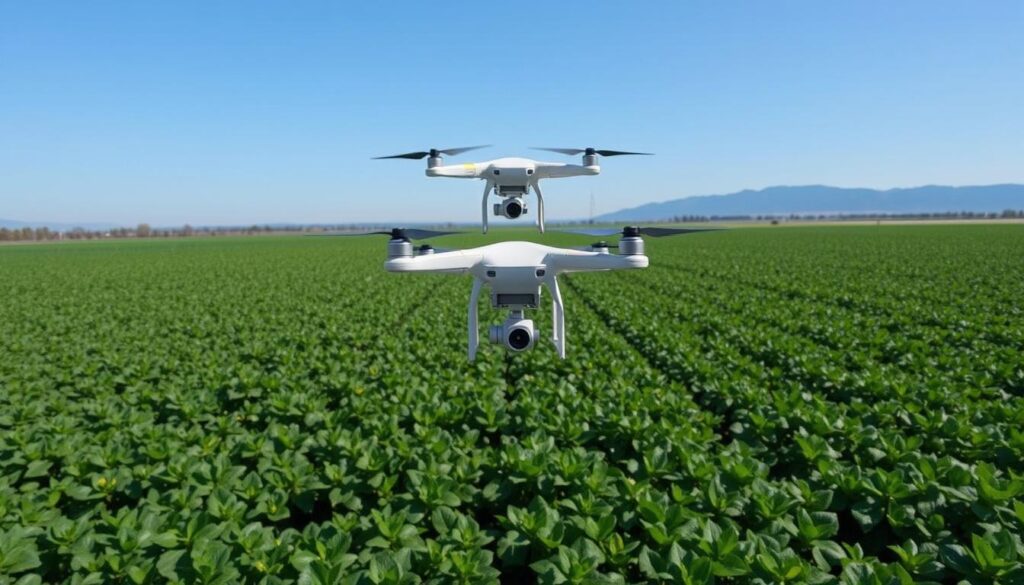
Farming faces many challenges today. Drones offer a new way to tackle these issues. They use special sensors to collect important data on plant health.
Using NDVI for Vegetation Analysis
The Normalized Difference Vegetation Index (NDVI) is a key tool for farmers. It helps them understand how well their crops are doing. By looking at how plants reflect light, farmers can see:
- Plant chlorophyll levels
- Vegetation density
- Overall crop vigor
- Potential stress indicators
“Drone technology transforms agricultural monitoring from reactive to proactive strategies.” – Agricultural Innovation Expert
Early Detection of Disease and Stress
Drones with multispectral sensors can scan big areas of land. This lets farmers spot problems early. They can then fix these issues before they get worse.
Here are some examples of how drones help in farming:
- California vineyards used NDVI sensors to improve grape quality
- Avocado orchards cut down water use with thermal imaging
- Wheat farms boosted yields by adjusting fertilization with drone data
Using drones in farming is a big step forward. It gives farmers the tools they need to grow crops better. This leads to more sustainable and efficient farming practices.
Water Resource Management through Drones
Drone technology has changed how we manage natural resources in permaculture. It gives us new insights into water systems and irrigation. Advanced drone technologies help farmers create efficient closed-loop systems. These systems use water better across farms.
Drone technology is key for farmers to monitor water resources. These drones collect important data on water distribution and moisture levels. They also help spot irrigation problems.
Assessing Irrigation Needs
Precision drone tech changes irrigation management. It lets farmers send water exactly where it’s needed. This reduces water waste by:
- High-resolution thermal imaging
- Multispectral sensor analysis
- Real-time soil moisture mapping
Monitoring Water Bodies and Aquifers
Drones with advanced sensors give deep insights into water systems. They quickly scan big areas to find:
- Potential water system leaks
- Underground aquifer conditions
- Watershed health indicators
“Drone technology represents a quantum leap in agricultural water management, transforming how we understand and utilize our most critical resource.”
Drone technology is a big step forward in sustainable farming. It gives farmers new tools for environmental monitoring and making smart decisions.
Pest and Weed Management
Modern permaculture tech integration is changing how we farm, focusing on pests and weeds. Drones are becoming key tools for farming, offering precise methods that harm the environment less.
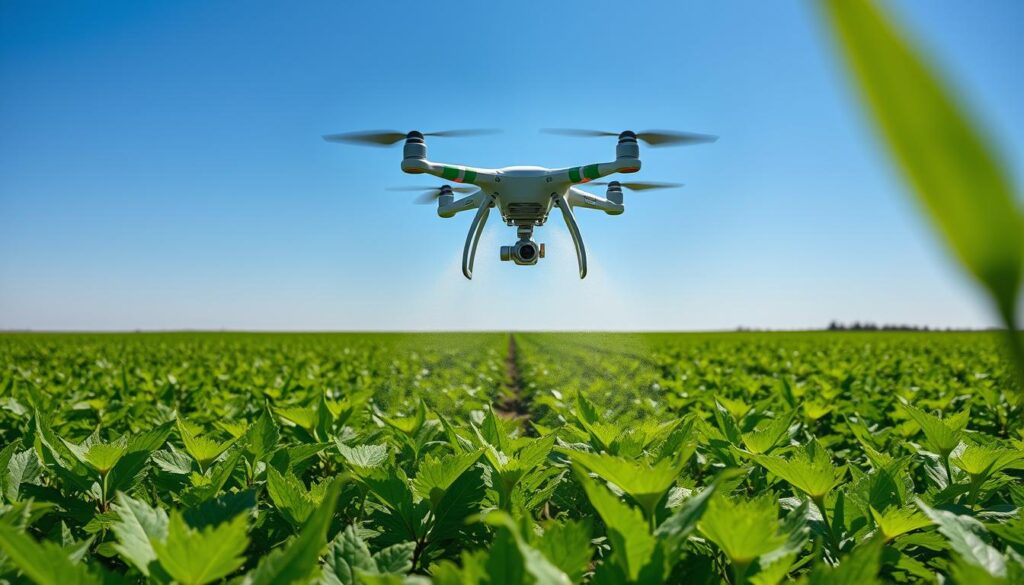
- Beans and corn yields can drop up to 50%
- Wheat yields may decrease by 48-60%
- Sesame crops could experience 50-75% yield reductions
Targeted Pesticide Application
Drone tech helps farmers use data-driven farming for better weed control. High-resolution images and sensors let farmers apply pesticides exactly where needed. This cuts down on chemicals and pollution.
Mapping Weed Infestations
Drone mapping lets farmers:
- Find where weeds are
- See how many weeds there are
- Watch how weeds change over time
- Plan better ways to fight weeds
“Precision is the key to sustainable agriculture. Drones transform how we understand and manage our fields.” – Agricultural Innovation Expert
With 266 weed species becoming resistant to herbicides, new methods like drones are vital. They help keep farms productive and protect the environment.
Tree and Plant Monitoring
Drones are changing how we watch over plant ecosystems in permaculture. They use advanced biomimic technologies to give us deep insights into how trees and plants grow. This is across many different types of farms.
For agriculture to grow in a regenerative way, we need new ways to see how plants develop. Drones with high-tech cameras and sensors can show us a lot about plant health and how they interact with their surroundings.
Tracking Growth Patterns in Agroforestry Systems
Today’s drones help us track how plants work together. Scientists can now study:
- Canopy density measurements
- How each plant grows
- Small changes in the environment
- Where nutrients go
Managing Perennial Crops with Precision
Drone tech makes managing long-term crops better by giving live updates on plant health and the environment. This helps farmers decide when to water, prune, and intervene.
“Technology lets us see ecosystems in a way we never could before.”
By using drone data and advanced analysis, permaculture experts can make their farms better. They use less resources and make their ecosystems stronger.
Community Engagement and Education
Sustainable agriculture grows when people share knowledge and learn together. Drone technology in permaculture is a great way to empower communities and bring technology into farming.
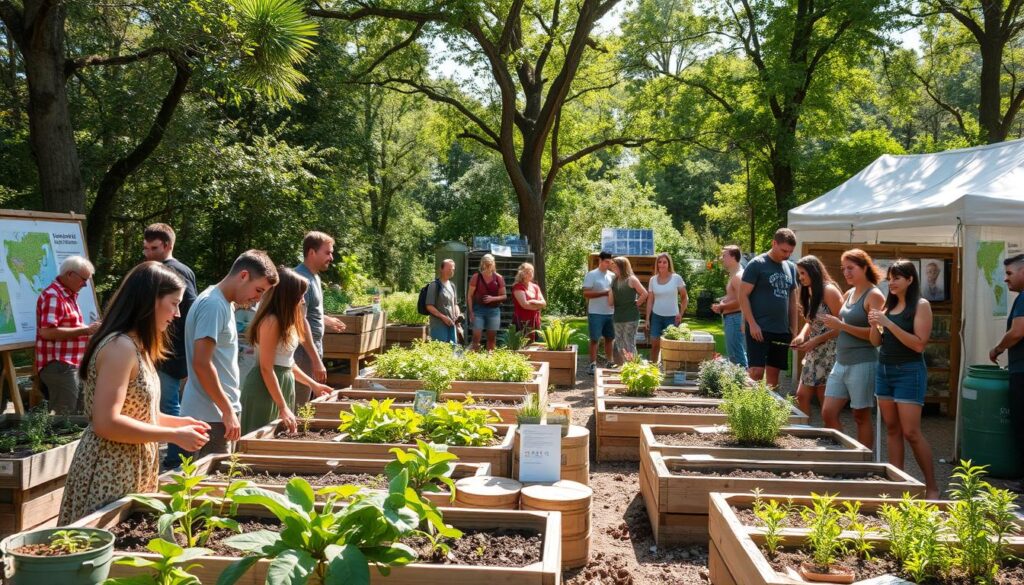
The world of ecological engineering is changing fast. Community involvement is key to improving farming practices. We need to teach farmers how to use drones in a way that fits with their traditional methods.
Training Workshops for Drone Operators
Teaching drone operators is about more than just flying a drone. It’s about learning:
- How to use drones well
- How to understand drone data
- How to use drones in permaculture
- How to stay safe and follow the law
Collaborating with Local Farmers
Working together is essential for using drones in farming. Experts and farmers need to team up. This way, they can share knowledge and use drones in real farming situations.
“Technology becomes truly transformative when it empowers local communities to solve their own challenges.”
| Training Focus | Skills Developed | Community Impact |
|---|---|---|
| Drone Operation | Technical Proficiency | Enhanced Agricultural Monitoring |
| Data Analysis | Ecological Understanding | Precision Resource Management |
| Regulatory Knowledge | Legal Compliance | Safe Technology Implementation |
Through education and teamwork, communities can make the most of drone technology in farming.
Regulatory Considerations for Drone Usage
Drone rules are key for managing natural resources in permaculture. The Federal Aviation Administration (FAA) has set clear guidelines. These rules help farmers and tech experts use drones in farming.
Understanding FAA Drone Regulations
Drone users in farming must follow strict federal rules. Important rules include:
- Mandatory drone registration for devices over 0.55 pounds
- Getting a Remote Pilot Certificate for commercial use
- Following specific flight height and speed limits
- Keeping the drone in sight during use
“Compliance is not just about following rules, but ensuring safe and responsible permaculture tech integration.” – FAA Agricultural Drone Guidelines
Permitting Requirements for Commercial Use
Commercial drone use in permaculture needs careful planning. Farmers must:
- Pass Part 107 knowledge testing
- Undergo background checks
- Get waivers for special operations
- Keep detailed operation records
The drone rules keep changing, making it hard for farmers to keep up. With 70% of farms thinking about drones, knowing these rules is crucial for green farming.
Successful permaculture innovation balances tech with rules.
Cost-Benefit Analysis of Drones in Permaculture
Drone technology is changing sustainable agriculture in big ways. It gives farmers new tools to manage resources better and grow crops with less harm to the environment.
Looking at the cost of agricultural technology, drones offer big benefits. They can change how farming is done.
Initial Investment vs. Long-Term Savings
Drone technology costs money at first, but it pays off in the long run. The main financial gains are:
- Less money spent on resources because they’re used where needed
- Better crop yields
- Less waste in farming
- Keeping an eye on crop health
Case Studies and Success Stories
Real-life examples show how drones are changing farming:
| Location | Drone Application | Outcome |
|---|---|---|
| California Vineyard | NDVI Sensor Mapping | Improved grape quality and yield |
| Wheat Farm | Precision Fertilization | Increased crop yields |
| Avocado Orchard | Thermal Imaging | Optimized water usage during drought |
“Drones are not just technology; they’re a strategic investment in sustainable agriculture’s future.” – Agricultural Innovation Expert
Adding AI and machine learning to drones makes them even more useful. Farmers get instant, useful information about their farms.
Integrating Drones into Existing Systems
Permaculture tech integration is changing farming. Farmers are now using drones in their sustainable farming systems. This new tech can change how we farm.
Adapting Current Practices
Using drones in farming needs careful planning. Farmers can add drones in several ways:
- Gradual technology introduction
- Comprehensive staff training programs
- Phased equipment investment
- Incremental workflow modifications
Technology Compatibility Strategies
Agroforestry systems need advanced tech. To use drones well, they must work with current farm systems.
“Technology integration is not about replacement, but enhancement of agricultural practices.” – Agricultural Innovation Expert
| Technology Integration Stage | Key Considerations | Potential Impact |
|---|---|---|
| Initial Assessment | Current system evaluation | 15% improved operational efficiency |
| Software Compatibility | Seamless data transfer | 25% enhanced decision-making |
| Hardware Integration | Drone-existing equipment interface | 30% precision increase |
Successful technology integration requires patience, strategic planning, and a commitment to continuous learning in agricultural innovation.
Environmental Impact Assessments
Drone technology has changed how we study the environment. It gives us new views into how ecosystems work. This lets researchers check the health of our planet without harming it.
Drone tech is now key for managing natural resources in permaculture. Seeing landscapes from above helps us understand how ecosystems work and how diverse they are.
Analyzing Biodiversity from Above
Drones with special sensors can collect detailed data about the environment. This tech helps us follow regenerative design better. It brings many benefits:
- Precise habitat mapping
- Wildlife population tracking
- Vegetation density assessment
- Ecosystem health monitoring
Minimizing Human Disturbance
Drone tech is great because it lets us study the environment with little human impact. This keeps sensitive areas safe and reduces harm to ecosystems.
| Ecological Assessment Method | Human Disturbance Level | Data Accuracy |
|---|---|---|
| Traditional Ground Surveys | High | Medium |
| Drone-Based Surveys | Low | High |
“Drones represent a transformative tool in ecological research, offering unprecedented insights while preserving the integrity of natural systems.” – Environmental Science Research Institute
Studies show drones help the environment a lot. Permaculture areas with drones have more bird species and biodiversity than regular farms.
Using drones, ecological engineers can make better plans for taking care of our land and saving nature.
Future Innovations in Drone Technology
The world of sustainable agriculture is changing fast. New biomimic technologies and advanced drones are leading the way. These changes are making farming better for farmers and the environment.
New drone tech is changing how we farm and deal with climate change. Artificial intelligence and machine learning are making drones smarter and more precise.
Advances in AI and Machine Learning
Artificial intelligence is making drones better for farming. Today’s drones have amazing features:
- Real-time data processing for crop management
- Autonomous decision-making algorithms
- Advanced multispectral sensor integration
- Predictive analysis for crop health
AI lets drones collect detailed data on crops. They can analyze light and reflectance in different ways. This helps farmers make quick, smart choices.
The Role of Drones in Climate Resilience
Drone tech is key to making farming more resilient to climate change. They help farmers monitor the environment closely. This lets farmers adjust to weather changes.
| Drone Capability | Climate Resilience Impact |
|---|---|
| Thermal Imaging | Optimize irrigation strategies |
| Multispectral Sensors | Detect early crop stress signals |
| IoT Connectivity | Real-time environmental monitoring |
“Drone technology represents the future of sustainable and intelligent agricultural practices.” – Agricultural Innovation Expert
As biomimic tech keeps improving, drones will play a bigger role. They will help create farming that is resilient, efficient, and good for the planet.
Case Studies of Successful Drone Applications
The fast growth of data-driven farming is changing farms in the United States. Drones are key in this change, giving farmers new ways to manage crops and watch the environment.
Drone tech is changing farming in big ways. The global agri-tech market is set to hit $41 billion by 2027. This shows a big chance for new tech in farming.
Farms Transforming with Drone Technology
Many farms are seeing big changes thanks to drones:
- California Almond Orchards: Used drones to map their land, saving 22% on water.
- Midwest Corn Farms: Found crop problems early with thermal imaging drones.
- Pacific Northwest Vineyards: Track plant health with detailed systems.
Research Initiatives and Their Outcomes
Research is showing drones can do a lot for farming. Some key results are:
- Remote monitoring could add $500 billion a year to farm value.
- Precision farming makes farming better for each spot.
- Advanced sensors help watch crops and the environment closely.
“Drones are not just technological tools, but transformative agents in modern agriculture.” – Agricultural Innovation Research Center
The global market for remote sensing satellites is growing fast. It’s expected to reach $29.19 billion by 2030. Drones are key to making farming more sustainable.
Conclusion: The Future of Drones in Permaculture
The mix of drone tech and permaculture is a big step for green farming. Drones are changing how we farm, making it better for the planet. Studies show drones can boost farm output by 10% and cut down on harm to the environment.
Expanding Adoption for Sustainable Practices
Drone tech is changing farms in the U.S. Farmers see drones as a way to save money and work smarter. They help farmers use resources better and cut down on costs by up to 30%. Drones also give farmers new ways to check on their crops and the health of their land.
The Path Ahead for Farmers and Technologists
Farmers and tech folks need to work together more. With climate change, 30% of farms might not work by 2050. Drones are key to making farms more resilient.
Every dollar spent on green farming brings in $2.50 in benefits. This makes using drones not just good for the planet but also smart for the wallet.
Looking ahead, drones in permaculture will keep making farming better. They’ll give farmers tools to make their farms more efficient, green, and productive.

